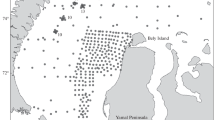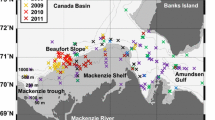Abstract—A review of the composition and structure of deep-sea pelagic ichthyocenes in the Bransfield Strait and northern Weddell Sea (Powell Basin) in the Atlantic sector of the Southern Ocean is presented. The material was obtained in summer 2020 and 2022 at 26 stations at layers from 120–0 to 2200–0 m. Nine hundred one specimens of juveniles and adult fishes belonging to 19 species from 10 families were collected. Statistical analysis made it possible to identify four significantly different regions in which the dominant ichthyocenes were located in waters of different origin. These ichthyocenes are poor in the number of identified species, but often quite numerous. Relatively shallow-water representatives of the families Bathydraconidae, Channichthyidae, Liparidae, and Nototheniidae, endemic to the shelf and slope of Antarctica, dominated in the area of the Antarctic Strait and on the shelf of the Antarctic Peninsula. At the same time in the Bransfield Strait, the abyssal basin of the Powell Basin, and in the pelagic zone above deep-sea ridges and trenches bordering it from the north, meso- and bathypelagic fish from the families Mycthophidae, Bathylagidae, Gonostomatidae, Paralepididae, and Scopelarchidae prevailed. Near the northern boundary of the Powell Basin, the number of mesobatypelagic species and their average abundance were higher than in its central part (11 vs. 7 species and 63.5 vs. 84.1 sp./100 m2). In the central part of the basin, Bathylagus antarcticus dominated, with an average share of 40% in catches and 28.8 sp./100 m2, while in the northern part of the basin, Electrona antarctica dominated, with an average share of 33%, 27.4 sp./100 m2.












Similar content being viewed by others
REFERENCES
E. G. Morozov, D. I. Frey, A. A. Polukhin, et al., “Mesoscale variability of the ocean in the northern part of the Weddell Sea,” Oceanology 60 (5), 573–588 (2020). https://doi.org/10.1134/S0001437020050173
E. G. Morozov, V. A. Spiridonov, T. N. Molodtsova, et al., “Investigations of the ecosystem in the Atlantic Sector of Antarctica (cruise 79 of the R/V Akademik Mstislav Keldysh),” Oceanology 60 (5), 721–723 (2020). https://doi.org/10.1134/S0001437020050161
M. E. Anderson, “The origin and evolution of the Antarctic ichthyofauna,” in Fishes of the Southern Ocean, Ed. by O. Gon and P. C. Heemstra (Smith Inst. Ichthyol., Grahamstown, 1990), pp. 28–33.
A. P. Andriashev, “A general review of the Antarctic fish fauna,” in Biogeography and Ecology of Antarctica (Junk Publisher, The Hague, 1965), pp. 491–550.
E. C. Carmack and T. D. Foster, “On the flow of water out of the Weddell Sea,” Deep-Sea Res. 22, 711–724 (1975). https://doi.org/10.1016/0011-7471(75)90077-7
I. A. Catalán, B. Morales-Nin, J. B. Company, et al., “Environmental influences on zooplankton and micronekton distribution in the Bransfield Strait and adjacent waters,” Polar Biol. 31, 691–707 (2008). https://doi.org/10.1007/s00300-008-0408-1
L. Chunlin, Z. Chi, L. Yang, et al., “Age and growth of Antarctic deep-sea smelt (Bathylagus antarcticus), an important mesopelagic fish in the Southern Ocean,” Deep-Sea Res. II 201, 1–11 (2022). https://doi.org/10.1016/j.dsr2.2022.105122
K. R. Clarke and R. M. Warwick, Primer-6 computer program (Natural Environment Research Council, Plymouth, 2005). http://refhub.elsevier.com/S0079-6611(16)30145-8/h0110. Accessed January 11, 2020.
M. A. Collins, G. Stowasser, S. Fielding, et al., “Latitudinal and bathymetric patterns in the distribution and abundance of mesopelagic fish in the Scotia Sea,” Deep-Sea Res. II 59, 189–198 (2012). https://doi.org/10.1016/j.dsr2.2011.07.003
Biogeographic Atlas of the Southern Ocean, Ed. by C. De Broyer, P. Koubbi, H. J. Griffths, (Scientifc Committee on Antarctic Research, Cambridge, 2014).
H. H. Dewitt, P. C. Heemstra, and O. Gon, “Nototheniidae,” in Fishes of the Southern Ocean, Ed. by O. Gon and P. C. Heemstra (Smith Inst. Ichthyol., Grahamstown, 1990), pp. 279–331.
J. Donnelly, T. T. Sutton, and J. J. Torres, “Distribution and abundance of micronekton and macrozooplankton in the NW Weddell Sea: Relation to a spring ice-edge bloom,” Polar Biol. 29, 280–293 (2006). https://doi.org/10.1007/s00300-005-0051-z
J. Donnelly and J. J. Torres, “Pelagic fishes in the Marguerite Bay region of the West Antarctic Peninsula continental shelf,” Deep-Sea Res. II 55, 523–539 (2008). https://doi.org/10.1016/j.dsr2.2007.11.015
J. T. Eastman, “The nature of the diversity of Antarctic fishes,” Polar Biol. 28, 93–107 (2005). https://doi.org/10.1007/s00300-004-0667-4
J. Gjosaeter and K. Kawaguchi, “A review of the world resources of mesopelagic fish,” FAO Fish. Tech. Pap., No. 193, 151 (1980).
T. M. Greely, J. V. Gartner Jr., and J. J. Torres, “Age and growth of Electrona antarctica (Pisces: Myctophidae) the dominant mesopelagic fish of the southern ocean,” Mar. Biol. 133, 145–158 (1999).https://doi.org/10.1007/s002270050453
G. Hempel, Antarctic marine food webs, in Antarctic Nutrient Cycles (Springer, Berlin, 1985).
T. L. Hopkins and J. J. Torres, “Midwater food web in the vicinity of a marginal ice zone in the western Weddell Sea,” Deep Sea Res. Part A. Oceanogr. Res. Pap. 36 (4), 543–560 (1989). https://doi.org/10.1016/0198-0149(89)90005-8
P. A. Hulley, “Results of the research cruises of FRV “Walther Herwig” to South America. 58. Family Myctophidae (Osteichthyes, Myctophiformes),” Arch. Fischereiwiss 31, 1–300 (1981).
W. G. Huneke, O. Huhn, and M. Schroeder, “Water masses in the Bransfield Strait and adjacent seas, austral summer 2013,” Polar Biol. 39, 789–798 (2016). https://doi.org/10.1007/s00300-016-1936-8
C. D. Jones, P. Koubbi, B. Catalano, et al., “Mesopelagic and larval fish survey,” NOAA Technical Memorandum NMFS SWFSC 524, 28–40 (2014).
J. P. Kennett, “Paleoceanographic and biogeographic evolution of the Southern Ocean during the Cenozoic, and Cenozoic microfossil datums,” Palaeogeogr., Palaeoclimatol., Palaeoecol. 31, 123–152 (1980). https://doi.org/10.1016/0031-0182(80)90017-6
A. Kellermann and K. H. Kock, “Patterns of spatial and temporal distribution and their variation in early life stages of Antarctic fish in the Antarctic Peninsula region,” in Antarctic Ocean and Resources Variability (Springer, Berlin, 1988), pp. 147–159.
A. Kellermann and S. Schadwinkel, “Winter aspects of the ichthyoplankton community in Antarctic Peninsula waters,” Polar Biol. 11, 117–127 (1991).
K. H. Kock, Antarctic fish, in Key Environments (Pergamon Press, Oxford, 1985), pp. 173–192.
K. H. Kock, Antarctic Fish and Fisheries (University Press, Cambridge, 1992).
V. A. Krechik, D. I. Frey, and E. G. Morozov, “Peculiarities of water circulation in the central part of the Bransfield Strait in January 2020,” Dokl. Earth Sci. 496 Part 1, 92–95 (2021). https://doi.org/10.1134/S1028334X21010116
J. B. Kruskal and M. Wish, Multidimensional Scaling, Quantitative Application in the Social Sciences (Sage Univ. Press, Beverly Hills, 1978).
T. M. Lancraft, J. J. Torres, and T. L. Hopkins, “Micronekton and macrozooplankton in the open waters near Antarctic ice edge zones (AMERIEZ 1983 and 1986),” Polar Biol. 9 (4), 225–233 (1989). https://doi.org/10.1007/BF00263770
T. M. Lancraft, T. L. Hopkins, J. Torres, and J. Donnelly, “Oceanic micronektonic/macrozooplanktonic community structure and feeding in ice covered Antarctic waters during the winter (AMERIEZ 1988),” Polar Biol. 11, 157–167 (1991). https://doi.org/10.1007/BF00240204
E. G. Morozov, V. A. Krechik, D. I. Frey, et al., “Frontal zone between relatively warm and cold waters in the northern Weddell Sea,” in Antarctic Peninsula Region of the Southern Ocean (Springer Nature, 2021), pp. 31–53. https://doi.org/10.1007/978-3-030-78927-5_3
E. J. Murphy, J. L. Watkins, P. N. Trathan, et al., “Spatial and temporal operation of the Scotia Sea ecosystem: A review of large-scale links in a krill centred food web,” Philos. Trans. R. Soc. London B 362, 113–148 (2007). https://doi.org/10.1098/rstb.2006.1957
R. L. O’Driscolla, G. J. Macaulaya, S. Gauthier, et al., “Distribution, abundance and acoustic properties of Antarctic silverfish (Pleuragramma antarcticum) in the Ross Sea,” Deep Sea Res. II 58, 181–195 (2011). https://doi.org/10.1016/j.dsr2.2010.05.018
A. H. Orsi, W. D. Nowlin, and IIIT. Whitworth, “On the circulation and stratification of the Weddell Gyre,” Deep-Sea Res. I 40, 169–203 (1993). https://doi.org/10.1016/0967-0637(93)90060-G
M. L. Parker, W. R. Fraser, J. Ashford, et al., “Assemblages of Micronektonic fishes and invertebrates in a gradient of regional warming along the Western Antarctic Peninsula,” J. Mar. Syst. 152, 18–41 (2015). https://doi.org/10.1016/j.jmarsys.2015.07.005
U. Piatkowski, M. White, and W. Dimmler, “Micronekton of the Weddell Sea: Distribution and abundance,” Berichte zur Polarforschung. Alfred-Wegener-Institut fur Polar-und Meeresforschung, 73–81 (1990).
U. Piatkowski, P. G. Rodhouse, M. G. White, et al., “Nekton community of the Scotia Sea as sampled by the RMT 25 during austral summer,” Mar. Ecol.: Proc. Ser. 112, 13–28 (1994). https://doi.org/10.3354/meps112013
Planetcalc. Catalog of online calculators. https://planetcalc. Version 3.0.4170.0. November 2022.
C. Pusch, P. A. Hulley, and K. H. Kock, “Community structure and feeding ecology of mesopelagic fishes in the slope waters of King George Island (South Shetland Islands, Antarctica),” Deep-Sea Res. I 51, 1685–1708 (2004).
J. M. Rembiszewski, M. Krzeptowski, and T. B. Linkowski, “Fishes (Pisces) as by-catch in fisheries for krill Euphausia superba Dana (Euphausiacea, Crustacea),” Pol. Arch. Hydrobiol. 25, 677–693 (1978).
H. C. Romesburg, Cluster Analysis for Researchers (Lulu.com, Morrisville, NC, 2004).
R. A. Saunders, M. A. Collins, G. Stowasser, and G. A. Tarling, “Southern Ocean mesopelagic fish communities in the Scotia Sea are sustained by mass immigration,” Mar. Ecol.: Proc. Ser. 569, 173–185 (2017). https://doi.org/10.3354/meps12093
K. E. Skóra and J. Sosiński, “Observations on the ichthyofauna distribution in the regions of the Scotia Sea and Antarctic Peninsula,” Polish Polar Research 4 (1–4), 49–55 (1983).
R. Tokarczyk, “Classification of water masses in the Bransfield Strait and southern part of the Drake Passage using a method of statistical multidimensional analysis,” Polish Polar Research 8, 333–336 (1987).
The Antarctic Silverfish: A Keystone Species in a Changing Ecosystem, Ed. by M. Vacchi, E. Pisano, and L. Ghigliotti (Springer, Cham, 2017).
T. Wenneck, T. Falkenhaug, and O. A. Bergstad, “Strategies, methods, and technologies adopted on the R.V. G.O. Sars MAR-ECO expedition to the Mid-Atlantic Ridge in 2004,” Deep-Sea Res. II 55, 6–28 (2008). https://doi.org/10.1016/j.dsr2.2007.09.017
M. G. White and U. Piatkowski, “Abundance, horizontal and vertical distribution of fish in eastern Weddell Sea micronekton,” Polar Biol. 13, 41–53 (1993).
Wikipedia. Grtat-circle distance. https://en.wikipedia.org/ w/index.php?title=Great-circle_dist.
Funding
The study was carried out within state task no. FMWE-2022-0001.
Author information
Authors and Affiliations
Corresponding author
Rights and permissions
About this article
Cite this article
Kobyliansky, S.G., Mishin, A.V., Orlov, A.M. et al. Spatial Structure of Deep-Sea Pelagial Ichthyocenes in the Northern Weddell Sea (Powell Basin) and Brunsfield Strait in Summer 2020 and 2022. Oceanology 63, 574–588 (2023). https://doi.org/10.1134/S0001437023040070
Received:
Revised:
Accepted:
Published:
Issue Date:
DOI: https://doi.org/10.1134/S0001437023040070




